Abstract
The alignment of lower extremities is an important consideration in many clinical situations, including fracture reduction, high tibia osteotomy, total knee arthroplasty, and deformity correction. Malalignment of lower extremities is not only a simple cosmetic problem, but it can also produce pain, limp, and early degenerative arthritis. An assessment of lower extremity alignment, including its location and magnitude of deformity, can be achieved via Malalignment test and mal-orientation test, using a lower extremity standing full-length radiography. Proper evaluation allows the surgeon to determine an effective treatment plan for deformity correction.
Go to : 
References
1. Beals RK, Stanley G. Surgical correction of bowlegs in achondroplasia. J Pediatr Orthop B. 14:245–249. 2005.

2. Cusick BD, Stuberg WA. Assessment of lower-extremity alignment in the transverse plane: implications for management of children with neuromotor dysfunction. Phys Ther. 72:3–15. 1992.

3. Song HR, Soma Raju VV, Kumar S, et al. Deformity correction by external fixation and/or intramedullary nailing in hypophosphatemic rickets. Acta Orthop. 77:307–314. 2006.

4. Tetsworth K, Paley D. Malalignment and degenerative arthropathy. Orthop Clin North Am. 25:367–377. 1994.

5. Felson DT, Niu J, Gross KD, et al. Valgus malalignment is a risk factor for lateral knee osteoarthritis incidence and progression: findings from the multicenter osteoarthritis study and the osteoarthritis initiative. Arthritis Rheum. 65:355–362. 2013.

6. Moreland JR, Bassett LW, Hanker GJ. Radiographic analysis of the axial alignment of the lower extremity. J Bone Joint Surg Am. 69:745–749. 1987.

7. Paley D, Herzenberg JE, Tetsworth K, McKie J, Bhave A. Deformity planning for frontal and sagittal plane corrective osteotomies. Orthop Clin North Am. 25:425–465. 1994.

8. Chao EY, Neluheni EV, Hsu RW, Paley D. Biomechanics of malalignment. Orthop Clin North Am. 25:379–386. 1994.

9. Cooke TD, Li J, Scudamore RA. Radiographic assessment of bony contributions to knee deformity. Orthop Clin North Am. 25:387–393. 1994.

10. Yoshioka Y, Siu D, Cooke TD. The anatomy and functional axes of the femur. J Bone Joint Surg Am. 69:873–880. 1987.

11. Brinker MR, O'Connor DP. Principles of malunions. Court-Brown CM, Heckman JD, McQueen MM, Ricci WM, III PT, editors. Rockwood and Green's fractures in adults. 8th ed.Philadelphia, Wolters Kluwer Health: 869–894;2015.
12. Lesiak AC, Vosseller JT, Rozbruch SR. Osteotomy, arthrodesis, and arthroplasty for complex multiapical deformity of the leg. HSS J. 8:304–308. 2012.

13. Krettek C, Miclau T, Grün O, Schandelmaier P, Tscherne H. Intraoperative control of axes, rotation and length in femoral and tibial fractures. Technical note. Injury, 29 Suppl. 3:C29–C39. 1998.

14. Sheehy L, Cooke TD, McLean L, Culham E. Standardized standing pelvis-to-floor photographs for the assessment of lower-extremity alignment. Osteoarthr Cartil. 23:379–382. 2015.

16. Hollister AM, Jatana S, Singh AK, Sullivan WW, Lupichuk AG. The axes of rotation of the knee. Clin Orthop Relat Res. 290:259–268. 1993.

17. Wright JG, Treble N, Feinstein AR. Measurement of lower limb alignment using long radiographs. J Bone Joint Surg Br. 73:721–723. 1991.

18. Paley D. Principles of deformity correction. 3rd ed.Berlin;Springer: 2005.
19. Holme TJ, Henckel J, Hartshorn K, Cobb JP, Hart AJ. Computed tomography scanogram compared to long leg radiograph for determining axial knee alignment. Acta Orthop. 86:440–443. 2015.

20. Sabharwal S, Zhao C. Assessment of lower limb alignment: supine fluoroscopy compared with a standing full-length radiograph. J Bone Joint Surg Am. 90:43–51. 2008.

21. Paley D, Tetsworth K. Mechanical axis deviation of the lower limbs. Preoperative planning of uniapical angular deformities of the tibia or femur. Clin Orthop Relat Res. 280:48–64. 1992.
22. Paley D. Principles of deformity correction. Berlin: Springer;p. 163. 2005.
Go to : 
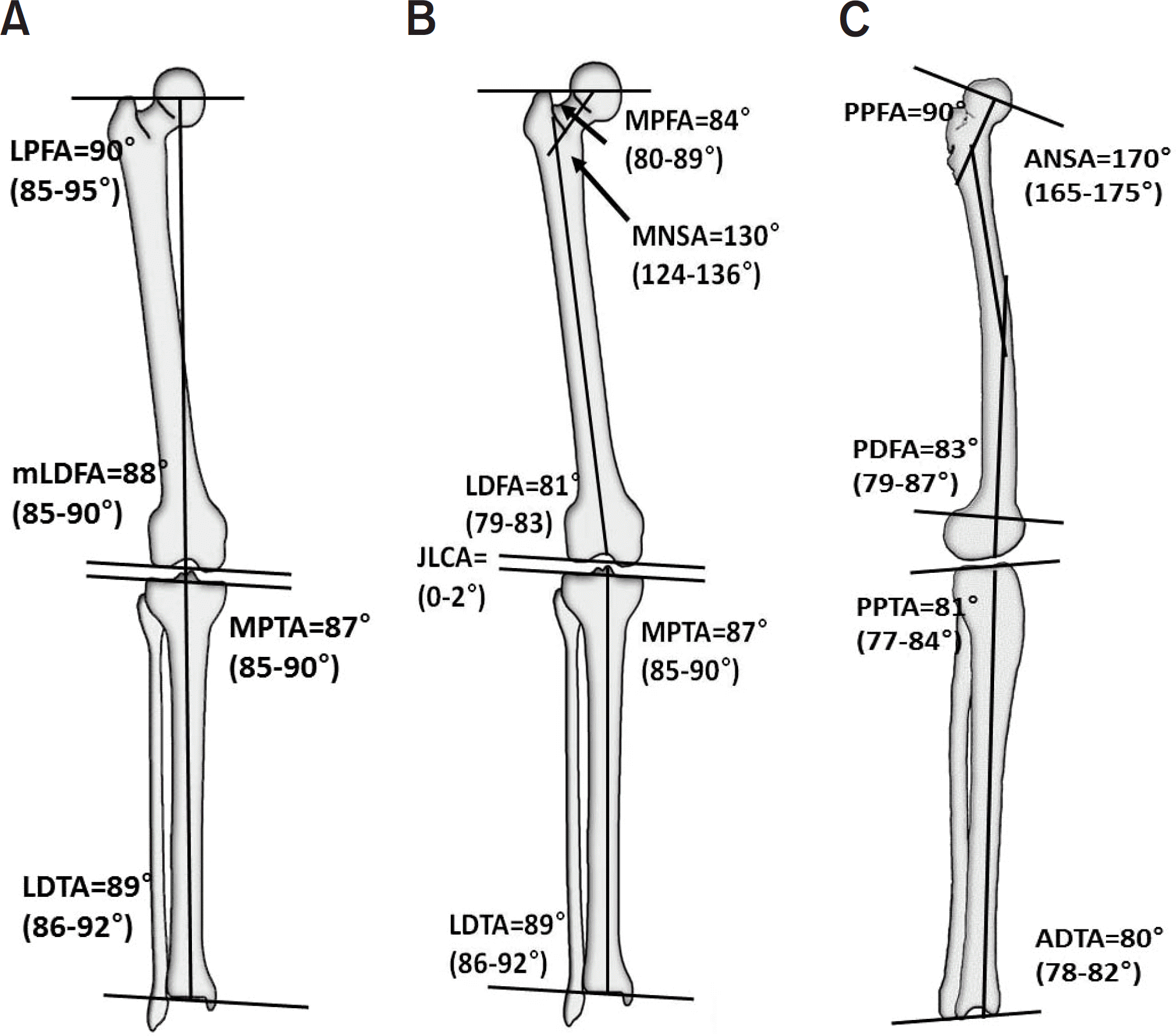 | Fig. 1.Nomenclature of the frontal plane joint orientation angle relative to the mechanical axis (A) and anatomic axis (B). (C) Nomenclature of the sagittal plane joint orientation angle relative to the anatomic axis. LPFA: lateral proximal femoral angle, mLDFA: mechanical lateral distal femoral angle, MPTA: medial proximal tibial angle, LDTA: lateral distal tibial angle, MPFA: medial proximal femoral angle, MNSA: medical neck shaft angle, LDFA: lateral distal femoral angle, JLCA: joint line convergence angle, PPFA: posterior proximal femoral angle, ANSA: anatomic neck shaft angle, PDFA: posterior distal femoral angle, PPTA: posterior proximal tibial angle, ADTA: anterior distal tibial angle. |
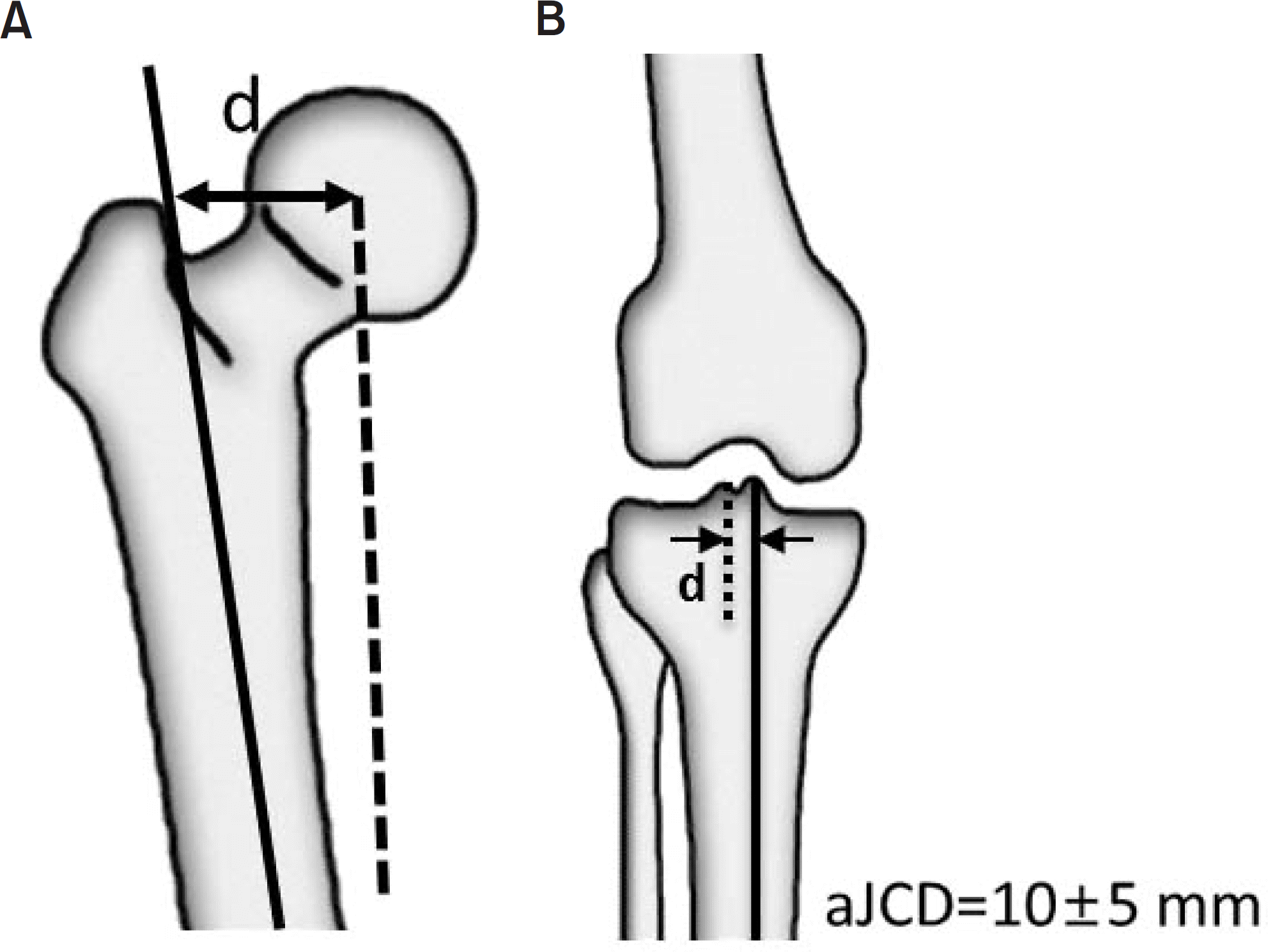 | Fig. 2.Anatomic axis to joint center distance (aJCD) of the hip joint of the hip (A) and tibia (B). Bold line: anatomic axis, Dot line: joint center point. d: distance. |
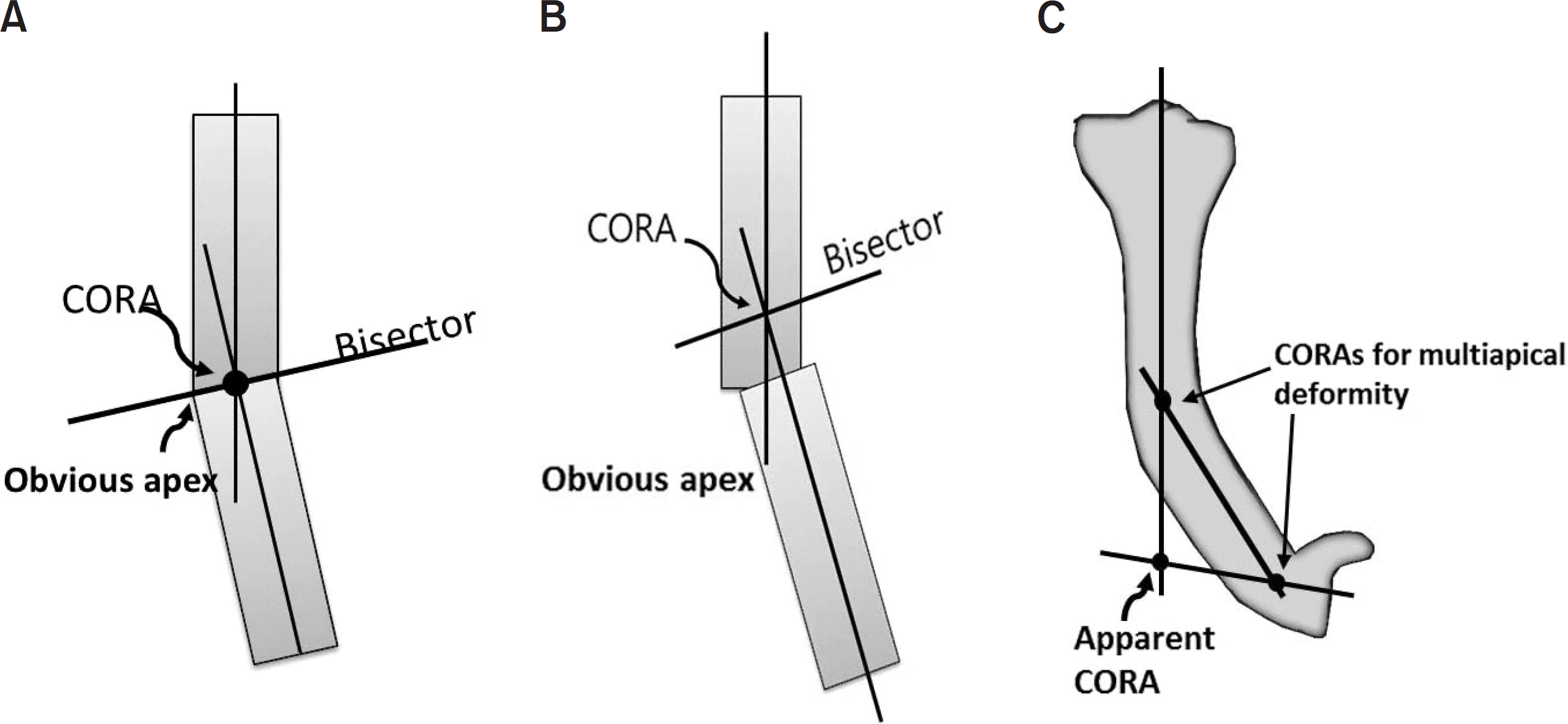 | Fig. 5.(A) If center of rotation of angulation (CORA) lies at the point of obvious deformity apex in the bone and the joint orientations are normal, the deformity is uniapical. (B) If CORA lies outside the point of obvious deformity apex or either joint orientation is abnormal, a second CORA exists in that plane and the deformity is multiapical or a translational deformity exists in that plane. (C) When the CORA lies outside the boundaries of the involved bone, a multiapical deformity is likely to be present. |
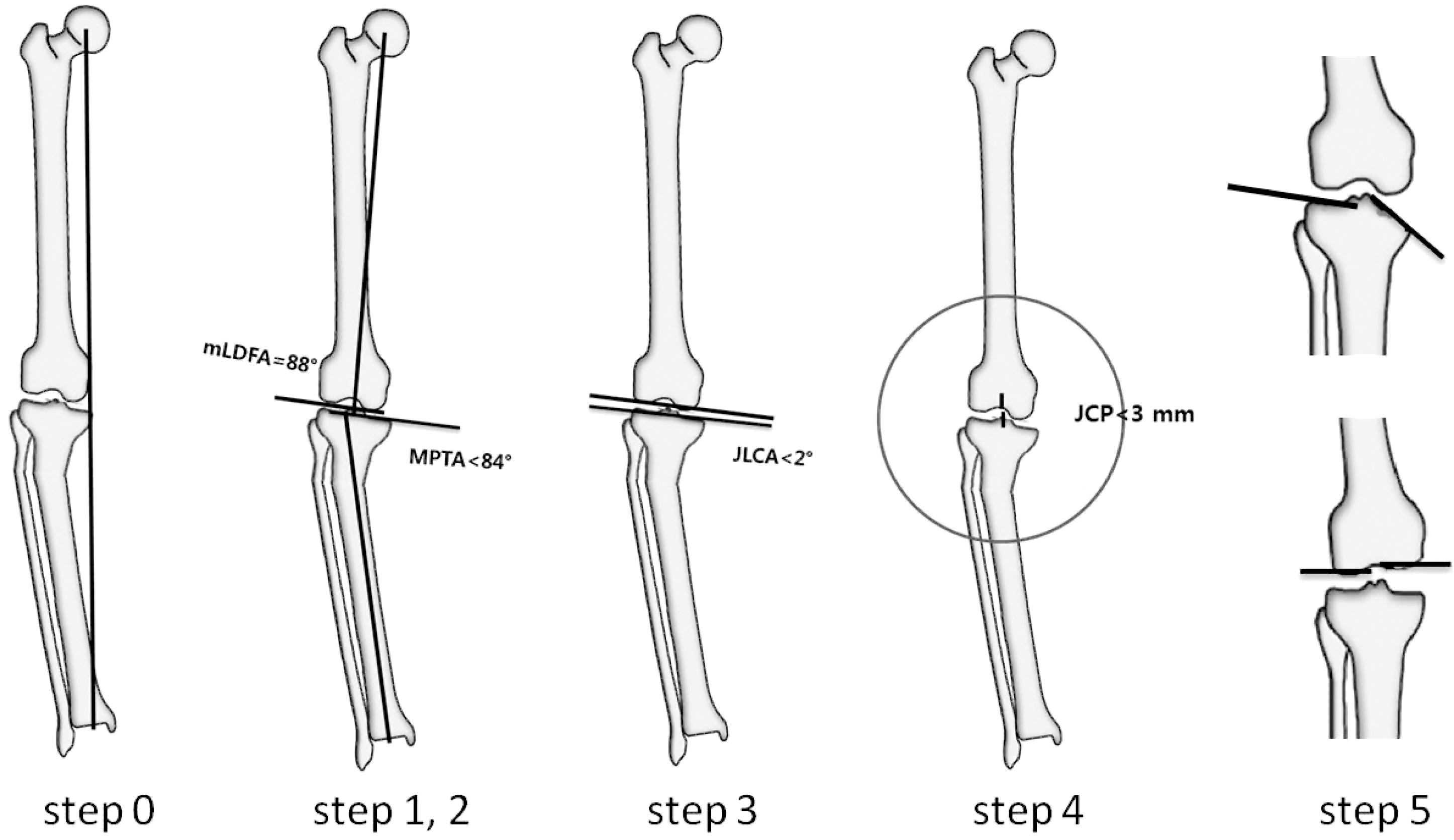 | Fig. 6.The Malalignment test is to identify the sources of mechanical axis deviation. Step 0 is to draw the mechanical axis; Step 1 is to measure the mLDFA; Step 2 is to measure the MPTA; Step 3 is to measure the JLCA; Step 4 is to measure the joint center distance; and Step 5 is to identify the joint surface Malalignment. mLDFA: mechanical lateral distal femoral angle, MPTA: medial proximal tibial angle, JLCA: joint line convergence angle, JCP: joint center point. |
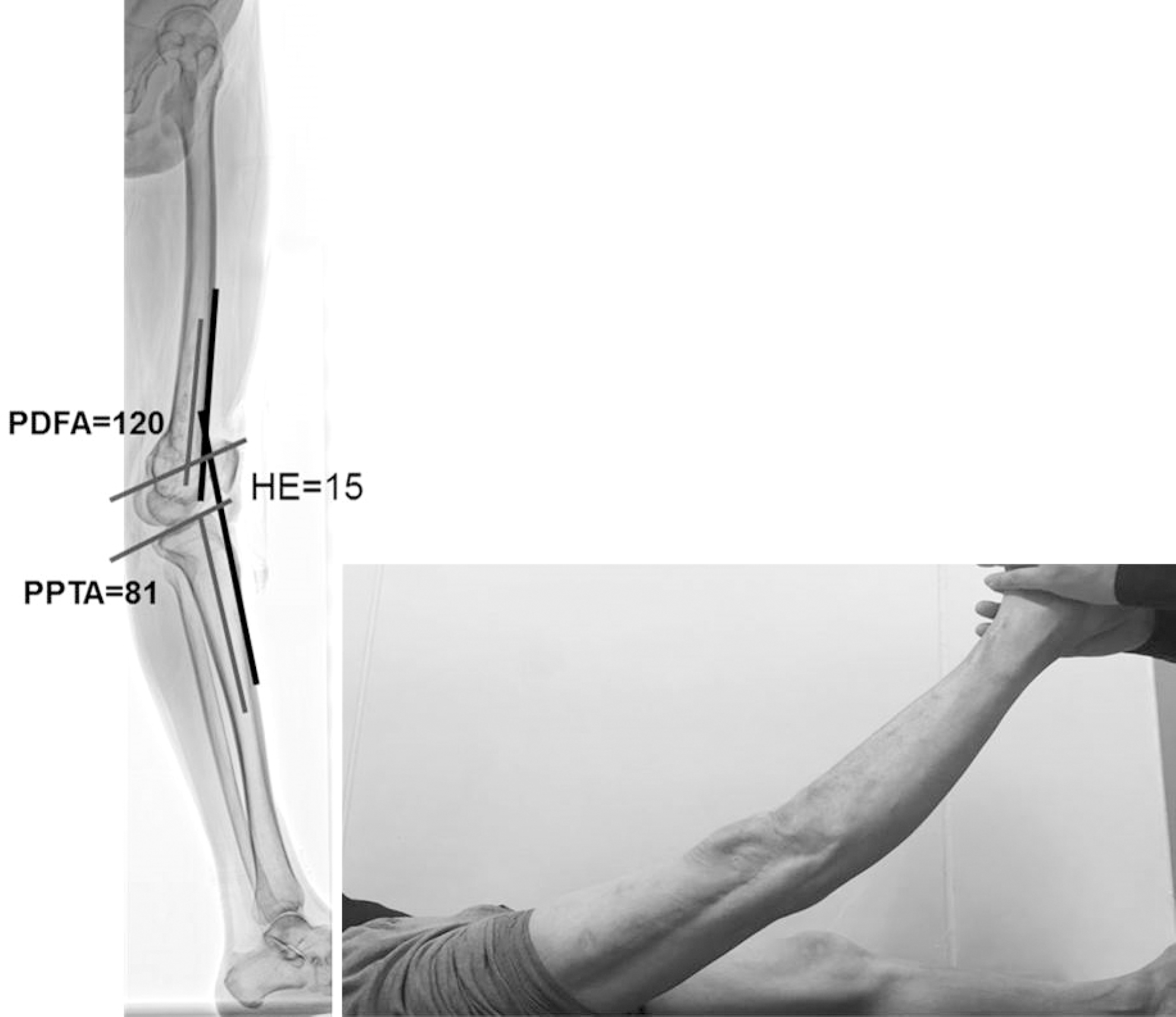 | Fig. 7.The standing lateral full length radiography of lower extremity shows 15° of hyperextension (HE) of the knee joint and 120° of PDFA, which is 36° recurvatum of the distal femur. Therefore, there is also 21° of knee joint flexion contracture and genu recurvatum. PDFA: posterior distal femoral angle, PPTA: posterior proximal tibial angle. |
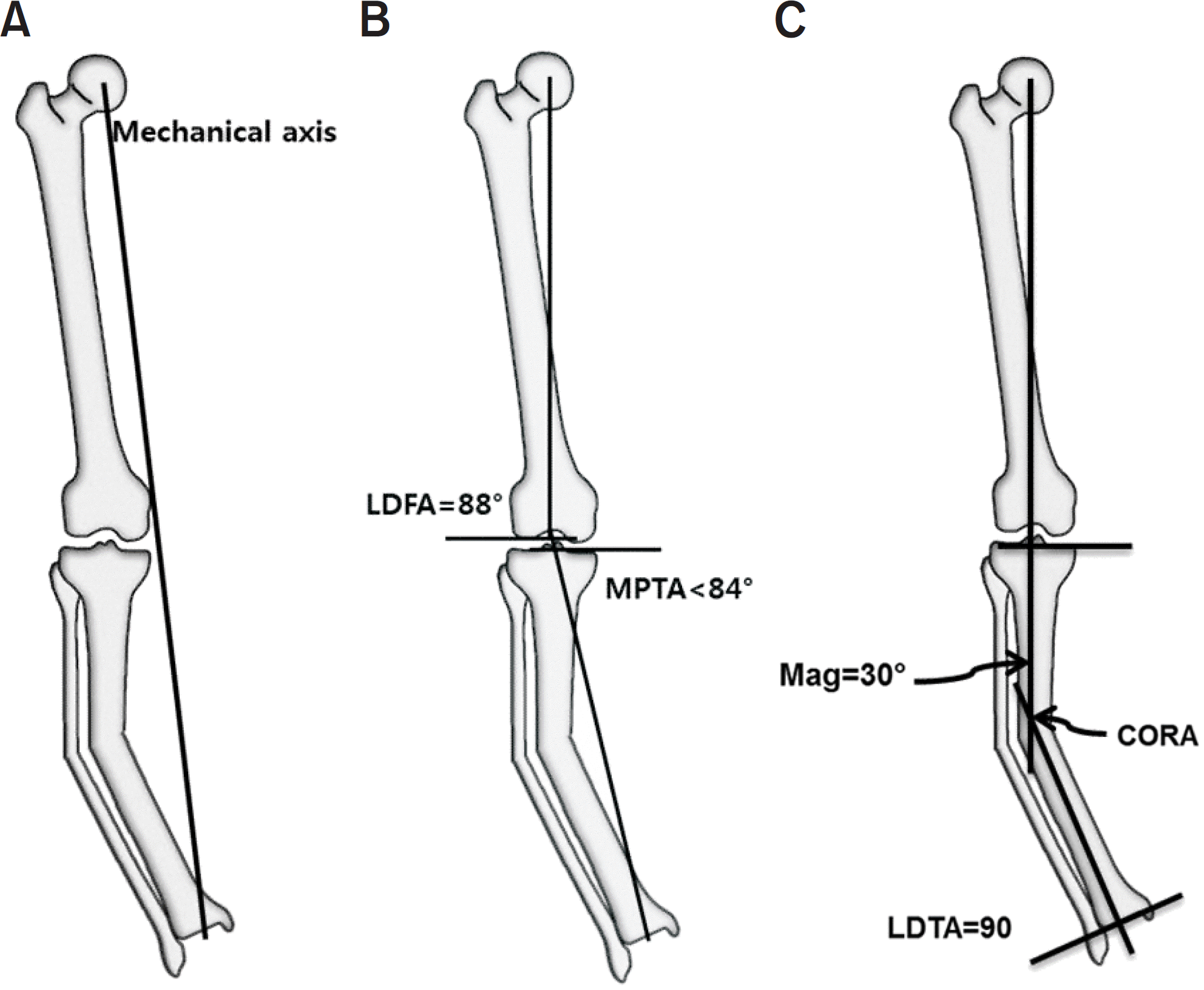 | Fig. 8.Analysis of uniapical deformity of the tibia using the mechanical axis: Draw the mechanical axis and measure MAD (A). Draw the mechanical axis of the femur and tibia. Measure mLDFA and MPTA (B). If MPTA is outside the normal range, the mechanical axis of the femur is extended distally as a mechanical axis line when mLDFA is within normal range. Draw the mechanical axis of distal tibia from the center of the ankle parallel to the diaphysis of the tibia and measure LDTA. If LDTA is within normal range, mark the CORA and measure the magnitude of angulation (C). MAD: mechanical axis deviation, mLDFA: mechanical lateral distal femoral angle, MPTA: medial proximal tibial angle, LDTA: lateral distal tibial angle, CORA: center of rotation of angulation, Mag: magnitude of deformity. |
Table 1.
Normal Values for Joint Orientation Angles in Lower Extremity
Table 2.
Clinical Signs and Symptoms Associated with Sagittal Plane Deformity of Lower Extremity21)




 PDF
PDF ePub
ePub Citation
Citation Print
Print


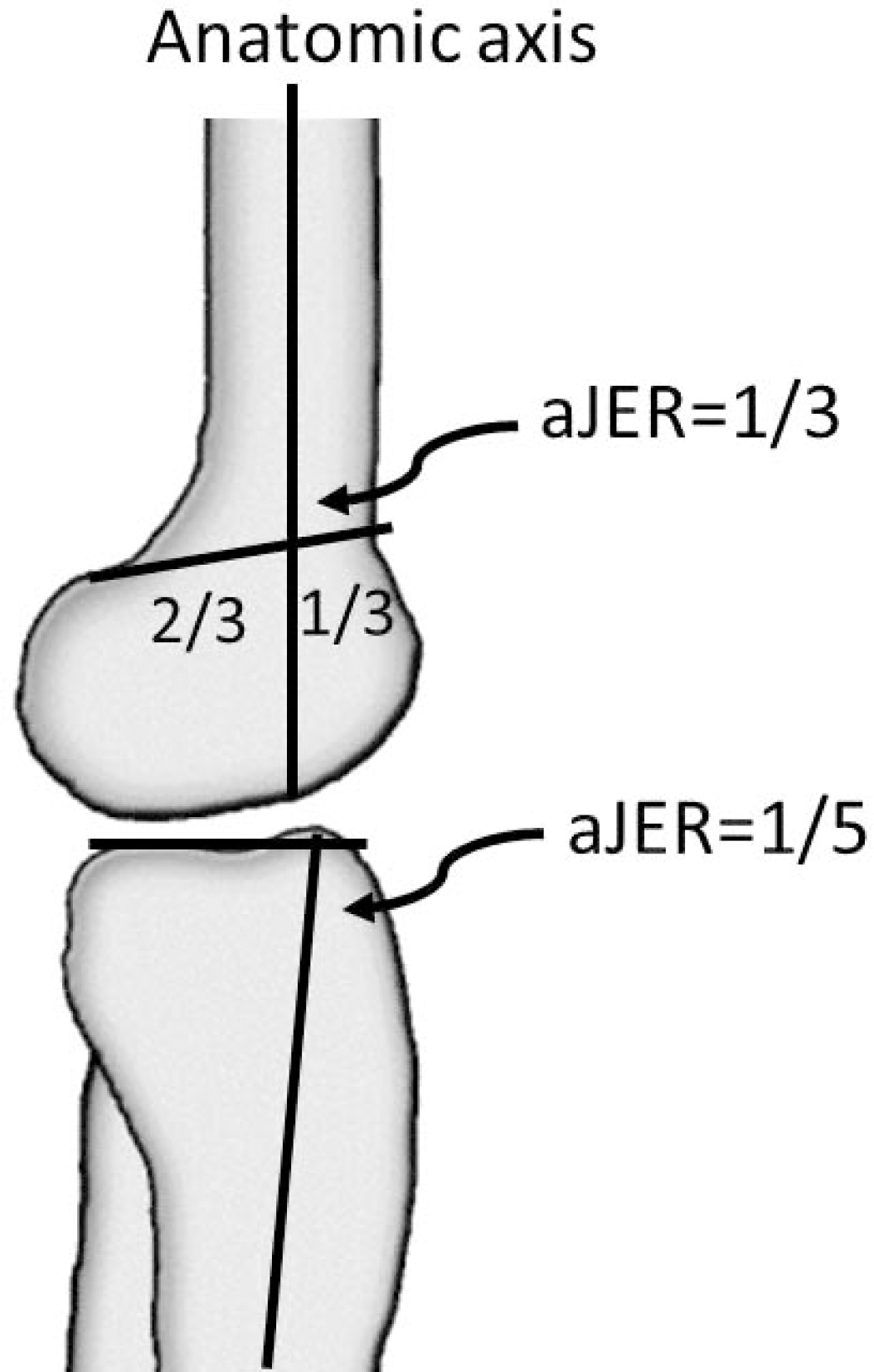
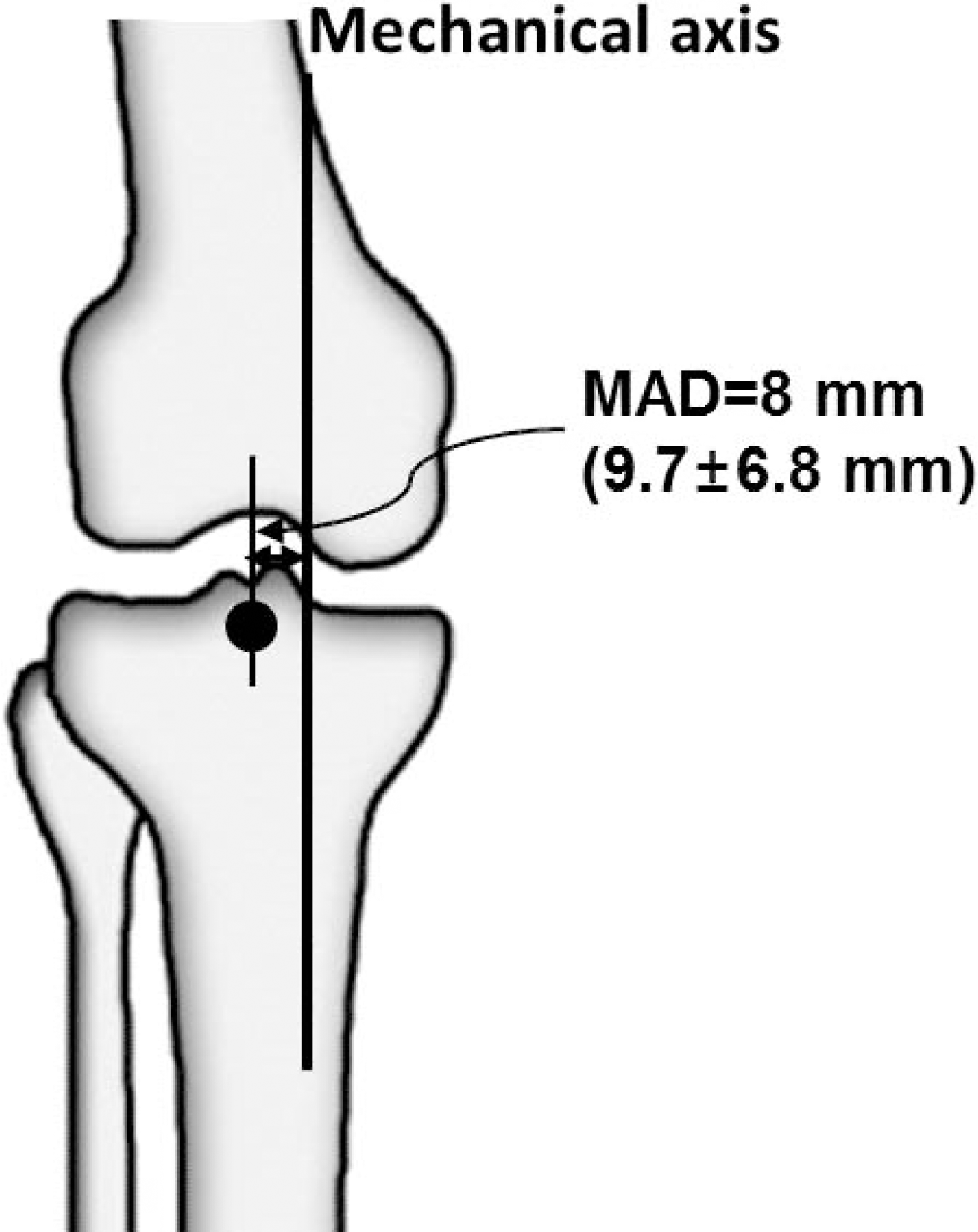
 XML Download
XML Download